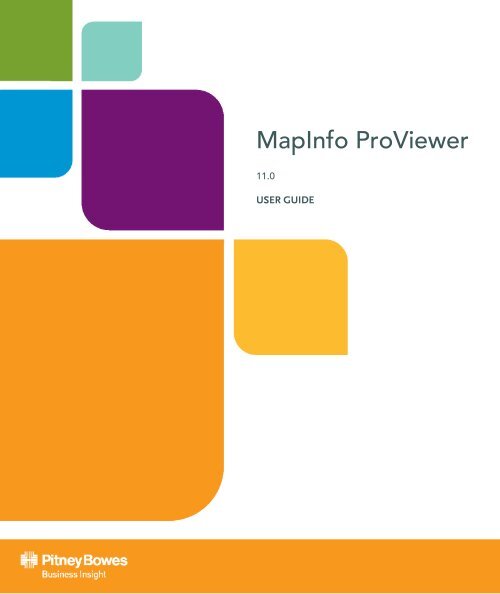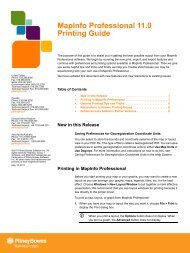MapInfo ProViewer User Guide - Product Documentation - MapInfo
MapInfo ProViewer User Guide - Product Documentation - MapInfo
MapInfo ProViewer User Guide - Product Documentation - MapInfo
You also want an ePaper? Increase the reach of your titles
YUMPU automatically turns print PDFs into web optimized ePapers that Google loves.
<strong>MapInfo</strong> <strong>ProViewer</strong><br />
11.0<br />
USER GUIDE
Information in this document is subject to change without notice and does not represent a commitment on the part of the vendor or its representatives. No part<br />
of this document may be reproduced or transmitted in any form or by any means, electronic or mechanical, including photocopying, without the written<br />
permission of Pitney Bowes Software Inc., One Global View, Troy, New York 12180-8399.<br />
© 2011 Pitney Bowes Software Inc. All rights reserved. <strong>MapInfo</strong>, Group 1 Software, and <strong>MapInfo</strong> <strong>ProViewer</strong> are trademarks of Pitney Bowes Software Inc. All<br />
other marks and trademarks are property of their respective holders.<br />
United States:<br />
Phone: 518.285.6000<br />
Fax: 518.285.6070<br />
Sales: 800.327.8627<br />
Government Sales: 800.619.2333<br />
Technical Support: 518.285.7283<br />
Technical Support Fax: 518.285.6080<br />
pbinsight.com<br />
Europe/United Kingdom:<br />
Phone: +44.1753.848.200<br />
Fax: +44.1753.621.140<br />
Technical Support: +44.1753.848.229<br />
pbinsight.co.uk<br />
Canada:<br />
Phone: 416.594.5200<br />
Fax: 416.594.5201<br />
Sales: 800.268.3282<br />
Technical Support:.518.285.7283<br />
Technical Support Fax: 518.285.6080<br />
pbinsight.ca<br />
Asia Pacific/Australia:<br />
Phone: +61.2.9437.6255<br />
Fax: +61.2.9439.1773<br />
Technical Support: 1.800.648.899<br />
pbinsight.com.au<br />
Contact information for all Pitney Bowes Software Inc. offices is located at: http://www.pbinsight.com/about/contact-us.<br />
© 2011 Adobe Systems Incorporated. All rights reserved. Adobe, the Adobe logo, Acrobat and the Adobe PDF logo are either registered trademarks or<br />
trademarks of Adobe Systems Incorporated in the United States and/or other countries.<br />
<strong>Product</strong>s named herein may be trademarks of their respective manufacturers and are hereby recognized. Trademarked names are used editorially, to the<br />
benefit of the trademark owner, with no intent to infringe on the trademark.<br />
May 12, 2011
Table of Contents<br />
Chapter 1: Introduction to<br />
<strong>MapInfo</strong> <strong>ProViewer</strong> . . . . . . . . . . . . . . . . . . . . . . . . . . . . . . . . . . . . . . . . . . . . . . . . . . 4<br />
System Requirements. . . . . . . . . . . . . . . . . . . . . . . . . . . . . . . . . . . . . . . . . . . . . . . . . . . . .5<br />
Installing <strong>MapInfo</strong> <strong>ProViewer</strong> . . . . . . . . . . . . . . . . . . . . . . . . . . . . . . . . . . . . . . . . . . . . . . .5<br />
What’s New in <strong>MapInfo</strong> <strong>ProViewer</strong>? . . . . . . . . . . . . . . . . . . . . . . . . . . . . . . . . . . . . . . . . .6<br />
Displaying a Map in <strong>MapInfo</strong> <strong>ProViewer</strong> . . . . . . . . . . . . . . . . . . . . . . . . . . . . . . . . . . . . . .7<br />
Understanding the <strong>ProViewer</strong> Toolbar . . . . . . . . . . . . . . . . . . . . . . . . . . . . . . . . . . . . . . .9<br />
A Brief Tour of the World.wor Workspace . . . . . . . . . . . . . . . . . . . . . . . . . . . . . . . . . . . .9<br />
Using the Select Icon . . . . . . . . . . . . . . . . . . . . . . . . . . . . . . . . . . . . . . . . . . . . . . . . . . .10<br />
Using the Statistics Icon. . . . . . . . . . . . . . . . . . . . . . . . . . . . . . . . . . . . . . . . . . . . . . . . .10<br />
Using the Ruler Icon. . . . . . . . . . . . . . . . . . . . . . . . . . . . . . . . . . . . . . . . . . . . . . . . . . . .11<br />
Using the Zoom Icons . . . . . . . . . . . . . . . . . . . . . . . . . . . . . . . . . . . . . . . . . . . . . . . . . .11<br />
Displaying the Map Legend . . . . . . . . . . . . . . . . . . . . . . . . . . . . . . . . . . . . . . . . . . . . . .12<br />
Printing Browser Window Contents . . . . . . . . . . . . . . . . . . . . . . . . . . . . . . . . . . . . . . . .13<br />
Getting Online Help. . . . . . . . . . . . . . . . . . . . . . . . . . . . . . . . . . . . . . . . . . . . . . . . . . . . . .14<br />
Getting Technical Support . . . . . . . . . . . . . . . . . . . . . . . . . . . . . . . . . . . . . . . . . . . . . . .14<br />
Want to do more? . . . . . . . . . . . . . . . . . . . . . . . . . . . . . . . . . . . . . . . . . . . . . . . . . . . . . . .14<br />
Appendix A: Glossary . . . . . . . . . . . . . . . . . . . . . . . . . . . . . . . . . . . . . . . . . . . . . . . 15<br />
Index . . . . . . . . . . . . . . . . . . . . . . . . . . . . . . . . . . . . . . . . . . . . . . . . . . . . . . . . . . . . . 18<br />
<strong>MapInfo</strong> <strong>ProViewer</strong> 11.0 3 <strong>User</strong> <strong>Guide</strong>
Introduction to<br />
<strong>MapInfo</strong> <strong>ProViewer</strong><br />
<strong>MapInfo</strong> <strong>ProViewer</strong> provides an easy way to see, print, and share electronic<br />
desktop maps. This convenient map viewer opens tables created using Pitney<br />
Bowes Software Inc. products such as <strong>MapInfo</strong> Professional or MapXtreme and<br />
displays them in Map and Browser windows. It also opens workspaces and recreates<br />
Map, Browser, Graph, and Layout windows exactly as they were<br />
created in <strong>MapInfo</strong> Professional. Using this product you can display and print<br />
maps and workspaces created in any version of the Pitney Bowes Software Inc.<br />
product line.<br />
The purpose of this chapter is to familiarize you with the basics of <strong>MapInfo</strong><br />
<strong>ProViewer</strong> and provide resources for you to become familiar with it. You can<br />
also get installation assistance from Technical Support, if necessary, using<br />
information in this document.<br />
� System Requirements . . . . . . . . . . . . . . . . . . . . . . . . . . . . . . . . . . . .5<br />
� Installing <strong>MapInfo</strong> <strong>ProViewer</strong> . . . . . . . . . . . . . . . . . . . . . . . . . . . . . .5<br />
� What’s New in <strong>MapInfo</strong> <strong>ProViewer</strong>? . . . . . . . . . . . . . . . . . . . . . . . . .6<br />
� Displaying a Map in <strong>MapInfo</strong> <strong>ProViewer</strong> . . . . . . . . . . . . . . . . . . . . .7<br />
� Understanding the <strong>ProViewer</strong> Toolbar . . . . . . . . . . . . . . . . . . . . . . .9<br />
� A Brief Tour of the World.wor Workspace . . . . . . . . . . . . . . . . . . . .9<br />
� Printing Browser Window Contents . . . . . . . . . . . . . . . . . . . . . . . .13<br />
� Getting Online Help . . . . . . . . . . . . . . . . . . . . . . . . . . . . . . . . . . . . .14<br />
� Getting Technical Support. . . . . . . . . . . . . . . . . . . . . . . . . . . . . . . .14<br />
� Want to do more?. . . . . . . . . . . . . . . . . . . . . . . . . . . . . . . . . . . . . . .14<br />
1
System Requirements<br />
Chapter 1: Introduction to <strong>MapInfo</strong> <strong>ProViewer</strong><br />
System Requirements<br />
<strong>MapInfo</strong> <strong>ProViewer</strong> is tested on the following Microsoft Windows Desktop Operating Systems:<br />
• Windows XP Professional 32-bit Service Pack 3 (SP3)<br />
• Windows 7 Ultimate 32-bit SP1<br />
• Windows 7 Ultimate 64-bit SP1 with 32-bit compatibility mode<br />
• Windows 2008 Server 32-bit SP2<br />
• Windows 2008 Server 32-bit SP2 with XenServer<br />
• Windows 2008 Server R2 64-bit SP1<br />
Dependencies and Prerequisites<br />
The <strong>MapInfo</strong> <strong>ProViewer</strong> install wizard checks for the following and prompts you if not already on your<br />
system; you can choose to have the install wizard install these requirements, or cancel the<br />
installation if you do not want to proceed.<br />
• Microsoft Office Access database engine 2010—does not install when the 64 bit office 2010<br />
driver is installed<br />
• Microsoft Office Access database engine 2007—only on a 64 bit Operating System that has the<br />
64 bit 2010 driver installed<br />
• Microsoft Visual C++ 2010 SP1 Redistributable Package (x86)<br />
• Microsoft .NET Framework 4.0 Full<br />
• Hotfix for Microsoft .NET Framework 4 Client Profile (KB2484832)<br />
• Hotfix for Microsoft .NET Framework 4 Client Profile (KB2498911)<br />
� Check the Microsoft website for the minimum requirements for these redistributables and<br />
updates if installing to an unsupported operating system.<br />
Installing <strong>MapInfo</strong> <strong>ProViewer</strong><br />
To install <strong>MapInfo</strong> <strong>ProViewer</strong>:<br />
1. Go to the directory where <strong>ProViewer</strong> is located and do the following:<br />
• Windows XP, 2008– double-click the Setup.exe file to start the installation process.<br />
• Windows 7 – right-click the Setup.exe file and select Run as administrator from the popup<br />
menu to install using elevated privileges. A prompt for permission to continue displays. Click<br />
Allow or Yes to proceed (if you do not respond and the message times-out, the install is<br />
unsuccessful).<br />
The wizard begins to lead you through the installation process.<br />
2. If any of the prerequisits listed under Dependencies and Prerequisites on page 5 are not<br />
already installed on your system, then a prompt displays to install them. Click Install.<br />
If you see a message that you require to reboot, click Yes. You must reboot to continue with the<br />
installation.<br />
3. In the Welcome screen, click Next.<br />
<strong>MapInfo</strong> <strong>ProViewer</strong> 11.0 5 <strong>User</strong> <strong>Guide</strong>
4. In the License Information screen, click I accept, and then click Next.<br />
Chapter 1: Introduction to <strong>MapInfo</strong> <strong>ProViewer</strong><br />
What’s New in <strong>MapInfo</strong> <strong>ProViewer</strong>?<br />
5. In the Customer Information screen, type in your user and organization names in the fields<br />
provided. Click Next.<br />
6. In the Destination Folder screen, click Next to accept the default path or click Change to select a<br />
new path.<br />
7. In the Ready to Install screen, click Install to begin the file transfer.<br />
8. In the Completed screen, click Finish to complete the installation of <strong>MapInfo</strong> <strong>ProViewer</strong>.<br />
What’s New in <strong>MapInfo</strong> <strong>ProViewer</strong>?<br />
This section contains information about the new features of <strong>ProViewer</strong>.<br />
New in Proviewer 11.0<br />
New Look for the Browser Window<br />
The Browser window has a new look and improved usability for viewing and editing data. It now:<br />
• Displays a very light background color on alternating rows for better readability.<br />
• Highlights an entire selected row. Previous versions use a small box at the left of the row to<br />
indicate selection state.<br />
The highlight color is set by your Windows display settings (by a theme). Highlighting does not<br />
appear in Layout windows or in printouts.<br />
Figure: A selected row in a Browser window.<br />
Multi-line text may display in any column, not just in expressions. Before version 11.0 <strong>MapInfo</strong><br />
<strong>ProViewer</strong> ignored carriage return characters in your data. As of version 11.0, <strong>MapInfo</strong> <strong>ProViewer</strong><br />
displays a row over multiple lines.<br />
Changing Column Width<br />
To resize a single column width, either:<br />
• Click and drag the edge of the column header.<br />
• Position the mouse cursor between two column headings and then double-click. The column to<br />
the left of the cursor resizes to fit the data in view.<br />
<strong>MapInfo</strong> <strong>ProViewer</strong> 11.0 6 <strong>User</strong> <strong>Guide</strong>
Scrolling and Viewing Data<br />
Chapter 1: Introduction to <strong>MapInfo</strong> <strong>ProViewer</strong><br />
Displaying a Map in <strong>MapInfo</strong> <strong>ProViewer</strong><br />
To reposition the column within the current view, select and drag a column heading.<br />
If you use the scroll bars to scroll, the current cell does not change position. This is similar to<br />
Microsoft Access and other programs, so the current cell can be out of view.<br />
Printing Browser Window Contents to PDF<br />
The new support for browser frames in a layout produces a raster image representation of the<br />
Browser window contents. If necessary, the raster image is broken into multiple, tiled images to<br />
handle large and/or high resolution browser frames that otherwise would run out of memory, or be<br />
unable to produce as a bitmap image. Due to the rasterization and/or tiling, you must enable or<br />
disable a setting to print to PDF as described under Printing Browser Window Contents on<br />
page 13.<br />
Displaying a Map in <strong>MapInfo</strong> <strong>ProViewer</strong><br />
To explore the basics of desktop mapping concepts, let’s explore the WORLD.WOR workspace,<br />
which is installed with <strong>ProViewer</strong> under the Data/World subfolder (for example, C:\Program<br />
Files\<strong>MapInfo</strong>\<strong>ProViewer</strong>\Data\World\WORLD.WOR).<br />
To display a map in the <strong>ProViewer</strong> product:<br />
1. Click the Start button, select the All Programs, <strong>MapInfo</strong> and <strong>MapInfo</strong> <strong>ProViewer</strong> to display the<br />
<strong>ProViewer</strong> window.<br />
2. Click the Open Tables or Workspaces tool or from the File menu, select Open to display<br />
the Open <strong>MapInfo</strong> Tables or Workspaces dialog box.<br />
<strong>MapInfo</strong> <strong>ProViewer</strong> 11.0 7 <strong>User</strong> <strong>Guide</strong>
Chapter 1: Introduction to <strong>MapInfo</strong> <strong>ProViewer</strong><br />
Displaying a Map in <strong>MapInfo</strong> <strong>ProViewer</strong><br />
� You cannot open .MWS files created with <strong>MapInfo</strong> Professional in <strong>ProViewer</strong>.<br />
3. Click the Data directory and click Open.<br />
4. Click the World directory and click Open.<br />
5. Select the World.wor entry and click Open to display the World workspace.<br />
<strong>MapInfo</strong> <strong>ProViewer</strong> 11.0 8 <strong>User</strong> <strong>Guide</strong>
Understanding the <strong>ProViewer</strong> Toolbar<br />
Chapter 1: Introduction to <strong>MapInfo</strong> <strong>ProViewer</strong><br />
Understanding the <strong>ProViewer</strong> Toolbar<br />
The toolbar icons at the top of the <strong>MapInfo</strong> <strong>ProViewer</strong> window can help you perform mapping work<br />
easily and efficiently. The Help System contains a detailed explanation of each icon.<br />
Open Tables or<br />
Workspace<br />
A Brief Tour of the World.wor Workspace<br />
Invert Selection Graph Select<br />
Select Print Window Zoom Out<br />
Change View Zoom In Info Tool<br />
Drag Map Window Grabber Show/Hide Legend<br />
Label Ruler Show/Hide Statistics<br />
Boundary Select HotLink Radius Select<br />
Polygon Select Marquee Select Unselect All<br />
Use the WORLD.WOR workspace, installed with <strong>ProViewer</strong>, to review the map layers and<br />
experiment with these icons to become familiar with their functionality. You can think of a workspace<br />
as a map with transparencies stacked on top of it. Each layer contains data that pertains to the entire<br />
map. For example, WORLD.WOR includes the Ocean, the Countries, and the World Capitals layers.<br />
The WORLD.WOR workspace is located under the Data/World subfolder where <strong>ProViewer</strong> is<br />
installed (for example, C:\Program Files\<strong>MapInfo</strong>\<strong>ProViewer</strong>\Data\World\WORLD.WOR).<br />
<strong>MapInfo</strong> <strong>ProViewer</strong> 11.0 9 <strong>User</strong> <strong>Guide</strong>
Using the Select Icon<br />
Chapter 1: Introduction to <strong>MapInfo</strong> <strong>ProViewer</strong><br />
A Brief Tour of the World.wor Workspace<br />
Click the Select tool and then position the cursor over any region to display the name of the<br />
region. There are several selection icons that allow you to select map features and group regions for<br />
display. See the Help System for more about the specific properties of each icon.<br />
Using the Statistics Icon<br />
Click the Show/Hide Statistics tool to display more about a selected country in the Statistics<br />
window.<br />
<strong>MapInfo</strong> <strong>ProViewer</strong> 11.0 10 <strong>User</strong> <strong>Guide</strong>
Using the Ruler Icon<br />
The Ruler tool can show distance between two points on a Map window.<br />
Chapter 1: Introduction to <strong>MapInfo</strong> <strong>ProViewer</strong><br />
A Brief Tour of the World.wor Workspace<br />
1. Choose the Ruler tool and position the cursor, which displays as a cross, anywhere on the<br />
map and click.<br />
The Ruler window displays Distance and Total. As you move the cursor, the Distance<br />
measurement changes in the Ruler window.<br />
• To measure the distance between two points, click the first point and double-click the second.<br />
• To measure the length of a path containing two or more segments, continue the process,<br />
clicking once at the end of each segment to keep a running total of the length of the path.<br />
Using the Zoom Icons<br />
The Zoom options give you control over the display of the Map window.<br />
1. Open a Map window and click the Zoom-in tool. Position the cursor anywhere on the map.<br />
Full featured Pitney Bowes Software Inc. products allow you to determine the range (for<br />
example 0 to 3 miles, 2 to 5 miles) at which each layer is visible in a Map window.<br />
2. To see the effect of zooming click the Zoom in icon anywhere on the map. The map redraws at<br />
the new zoom level. Notice that the information changes in the Zoom section of the Status Bar<br />
to reflect a new zoom level.<br />
<strong>MapInfo</strong> <strong>ProViewer</strong> 11.0 11 <strong>User</strong> <strong>Guide</strong>
Chapter 1: Introduction to <strong>MapInfo</strong> <strong>ProViewer</strong><br />
A Brief Tour of the World.wor Workspace<br />
3. To specify the zoom level of the map, click the Change View tool and enter a new zoom<br />
level.<br />
At different zoom levels, new information displays on the map reflecting the visibility of the<br />
different map layers that comprise WORLD.WOR.<br />
Displaying the Map Legend<br />
The map’s legend explains the meaning of the different shapes, colors, and fill patterns.<br />
1. Open a Map window and click the Show/Hide Legend tool or select the Options menu and<br />
the Show/Hide Legend command.<br />
� Not all maps have legends.<br />
2. Choose the Map menu option and the Previous View command to return the map from the<br />
beginning.<br />
<strong>MapInfo</strong> <strong>ProViewer</strong> 11.0 12 <strong>User</strong> <strong>Guide</strong>
Chapter 1: Introduction to <strong>MapInfo</strong> <strong>ProViewer</strong><br />
Printing Browser Window Contents<br />
We have provided the icon descriptions, the Glossary, and the online help to support you as you<br />
navigate through more mapping adventures!<br />
Printing Browser Window Contents<br />
When selecting to print the contents of a Browser window:<br />
• Only the contents in view print. If necessary, the contents are scaled down (preserving the<br />
aspect ratio) to fit the page size.<br />
• Only full rows and columns print, partial rows or columns are not in the printout.<br />
• Scroll bars, at right and at bottom, do not print. Other controls for on-screen clicking, such as a<br />
selection box, do not print.<br />
• You cannot specify a page range for printing and you cannot print to file.<br />
Browser frames in a layout produces a raster image representation of the Browser window contents.<br />
If necessary, the raster image is broken into multiple, tiled images to handle large and/or high<br />
resolution browser frames that otherwise would run out of memory, or be unable to produce as a<br />
bitmap image. Due to the rasterization and/or tiling, you must do the following when printing to PDF.<br />
Printing to the <strong>MapInfo</strong> PDF Printer<br />
When printing to the <strong>MapInfo</strong> PDF printer, you must enable Postscript Simulation. You can set this<br />
value for each print job, or change the default by editing the properties for this driver in Control Panel<br />
Printers.turn off<br />
1. From the File menu, select Print.<br />
2. In the Print dialog box, select the <strong>MapInfo</strong> PDF Printer.<br />
3. Click Properties.<br />
4. In the Properties dialog box, click the Advanced Options tab.<br />
5. Make sure the Enable Postscript Simulation checkbox is checked.<br />
6. Click OK to close the dialogs and save your setting.<br />
Printing to the Adobe PDF Printer<br />
When printing to the Adobe PDF printer, you must turn off Image Downsample. Since there are<br />
multiple versions of the Adobe PDF printer, these directions may vary based on which version of the<br />
Adobe printer is being used. These settings can be either be set at print time, or set in Control Panel<br />
Printers to change the default for all print jobs.<br />
1. From the File menu, select Print.<br />
2. In the Print dialog box, select Adobe PDF Printer.<br />
3. Click Properties.<br />
4. In the Properties dialog box, select the General tab and click Printing Preferences.<br />
5. Select the Images category.<br />
<strong>MapInfo</strong> <strong>ProViewer</strong> 11.0 13 <strong>User</strong> <strong>Guide</strong>
Chapter 1: Introduction to <strong>MapInfo</strong> <strong>ProViewer</strong><br />
Getting Online Help<br />
6. For all types of Images (Color, Grayscale, Monochrome), set Downsample to Off.<br />
7. Click OK to close the dialogs and save your setting.<br />
Getting Online Help<br />
Use <strong>ProViewer</strong>‘s comprehensive online Help, including sections on menu commands and dialog box<br />
descriptions, to answer your <strong>ProViewer</strong> questions.<br />
Getting Technical Support<br />
If you encounter problems installing <strong>MapInfo</strong> <strong>ProViewer</strong>, our technical support specialists can help.<br />
Technical Support for <strong>MapInfo</strong> <strong>ProViewer</strong> is limited to installation issues. For workspace-related<br />
issues, see the <strong>MapInfo</strong> Professional user who created the workspace.<br />
To contact the office nearest you, refer to the Support > Contact Support section on our website:<br />
http://www.pbinsight.com/support/contact-support/<br />
Want to do more?<br />
Consider...<br />
<strong>MapInfo</strong> Professional, the premier desktop mapping product for business and government. <strong>MapInfo</strong><br />
Professional allows users to access their own data to see relationships between data and<br />
geography, answering questions such as...<br />
• Where are my best customers located?<br />
• Where should I place my next sales office?<br />
• How can I increase my sales?<br />
<strong>MapInfo</strong> Professional answers these questions in a straightforward manner, reducing the time it<br />
takes to make smarter decisions.<br />
<strong>MapInfo</strong> <strong>ProViewer</strong> 11.0 14 <strong>User</strong> <strong>Guide</strong>
Glossary<br />
This section contains a list of terms we use to describe <strong>ProViewer</strong> features and<br />
capabilities.<br />
A
Term Definition<br />
Chapter A: Glossary<br />
Browser A window for viewing a table (or database, spreadsheet or text file) in tabular form.<br />
Coordinate An x,y location in a Cartesian coordinate system, or a Latitude, Longitude location<br />
in an earth coordinate system. Coordinates represent locations on a map relative<br />
to other locations. Earth coordinate systems may use the equator and the<br />
Greenwich prime meridian as fixed reference points. Plane coordinate systems<br />
describe a two-dimensional x,y location in terms of distance from a fixed reference<br />
and are usually in the first quadrant so that all coordinates are positive numbers.<br />
Degrees Longitude,<br />
Degrees Latitude,<br />
Decimal Degrees<br />
Degrees (longitude and latitude) are coordinates used to represent locations on the<br />
surface of the earth. Longitude, or X-coordinate, represents a location’s east-west<br />
position, where any location west of the prime meridian has a negative X value.<br />
Latitude, or Y-coordinate, represents a location’s north-south position, where any<br />
location south of the equator has a negative Y value.<br />
Field A field in a table corresponds to a column in a Browser. A field contains a specific<br />
type of information about an object, such as, name, abbreviation, land area, price,<br />
population, and so forth. The record for each object consists of that object’s values<br />
for each of the fields in the database.<br />
Graticule A grid of horizontal (latitude) and vertical (longitude) lines displayed on an earth<br />
map, spaced at a regular distance (for example, every five degrees, every fifteen<br />
degrees). Used to establish a frame of reference.<br />
Latitude The horizontal lines on a map that increase from 0 degrees at the Equator to 90<br />
degrees at both the North (+90.0 degrees) and South (-90.0 degrees) poles. Used<br />
to describe the North-South position of a point as measured usually in degrees or<br />
decimal degrees above or below the equator.<br />
Legend The part of a map, which explains the meaning of different colors, shapes, or fill<br />
patterns used on the map.<br />
Longitude The vertical lines on a map, running from the North to South poles, used to<br />
describe the east-west position of a point. The position is reported as the number<br />
of degrees east (to -180.0 degrees) or west (to +180.0 degrees) of the prime<br />
meridian (0 degrees). Lines of longitude are farthest apart at the Equator and<br />
intersect at both poles, and therefore, are not parallel.<br />
Map Scale A statement of a measure of the map and the equivalent measure on the earth.<br />
Often expressed as a representative ratio of distance, such as 1:10,000. This<br />
means that one unit of distance on the map (for example, one inch) represents<br />
10,000 of the same units of distance on the earth.<br />
The term scale must be used carefully. Technically, a map of a single city block is<br />
large–scale (for example, 1:12,000), while a map of an entire country is small–<br />
scale (for example, 1:1,000,000). A 1:1,000,000 map is considered small-scale<br />
because of the small numeric value obtained when you divide 1 by 1,000,000.<br />
<strong>MapInfo</strong> <strong>ProViewer</strong> 11.0 16 <strong>User</strong> <strong>Guide</strong>
Term Definition<br />
Map window A window that allows you to view a table as a map.<br />
Chapter A: Glossary<br />
Node An end-point of a line object, or an end-point of a line segment which is part of a<br />
polyline or region object.<br />
Raster Image A type of computerized picture consisting of row after row of tiny dots (pixels).<br />
Raster images are sometimes known as bitmaps. Aerial photographs and satellite<br />
imagery are common types of raster data found in GIS. A computer image can be<br />
represented in raster format or in vector format. See Vector Image on page 17.<br />
Record All the information about one object in a database or table. A record in a table<br />
corresponds to a row in a Browser.<br />
Selection A data item or set of data items chosen for inspection and/or analysis. Regardless<br />
of the kinds of windows on the screen, selections can be made using the Select<br />
and SQL Select Query commands in <strong>MapInfo</strong> Professional’s Query menu. In<br />
Browsers and Map windows, items can be placed in the selection set by clicking on<br />
them individually. Map windows also have special tools for selecting multiple items<br />
on a spatial basis.<br />
Status Bar A bar at the bottom of the screen that displays messages that help in using<br />
<strong>MapInfo</strong> Professional. The StatusBar also displays messages that pertain to the<br />
active window. In a Map window, the StatusBar indicates what layer is editable, the<br />
zoom display of the map, and the status of Snap and Digitizing modes. In a<br />
Browser window, the StatusBar indicates the number of records currently<br />
displaying and the total number of records. In a Layout window, the StatusBar<br />
indicates the zoom display as a percentage of the actual size of the map.<br />
Table A table is made up of data in rows and columns. Each row contains information<br />
about a particular geographic feature, event, etc. Each column contains a<br />
particular kind of information about the items in the table. You can display tables<br />
with graphic information stored in them as maps.<br />
Vector Image A coordinate-based data structure commonly used to represent map features.<br />
Each object is represented as a list of sequential x,y coordinates. Attributes may be<br />
associated with the objects. A computer image can be represented in vector format<br />
or in raster format. See Raster Image on page 17.<br />
Workspace A saved configuration of open <strong>MapInfo</strong> tables and windows.<br />
Zoom Layering A setting that determines the range (for example, 0–3 miles, 2–5 miles, etc.) at<br />
which a layer is visible in a Map window.<br />
<strong>MapInfo</strong> <strong>ProViewer</strong> 11.0 17 <strong>User</strong> <strong>Guide</strong>
Index<br />
B<br />
Browser windows<br />
defined 16<br />
C<br />
coordinates<br />
defined 16<br />
D<br />
degrees latitude definition 16<br />
degrees longitude definition 16<br />
Displaying a Map 7<br />
F<br />
fields definition 16<br />
G<br />
graticule definition 16<br />
H<br />
Help<br />
getting online 14<br />
L<br />
latitude definition 16<br />
Legend, displaying a map’s 12<br />
longitude, defined 16<br />
M<br />
map scale<br />
defined 16<br />
Map windows<br />
defined 17<br />
Map, displaying in <strong>ProViewer</strong> 7<br />
<strong>MapInfo</strong> Professional<br />
technical support 14<br />
<strong>MapInfo</strong> Professional, getting more out of maps<br />
with 14<br />
<strong>MapInfo</strong> <strong>ProViewer</strong> 11.0 18 <strong>User</strong> <strong>Guide</strong><br />
N<br />
nodes<br />
defined 17<br />
P<br />
<strong>ProViewer</strong><br />
displaying a map in 7<br />
installing 5<br />
understanding the toolbar 9<br />
R<br />
raster images<br />
defined 17<br />
record definition 17<br />
Ruler icon 11<br />
S<br />
Select icon 10<br />
Statistics icon 10<br />
status bar<br />
defined 17<br />
support<br />
technical support 14<br />
T<br />
tables<br />
defined 17<br />
technical support<br />
obtaining 14<br />
Technical Support, getting 14<br />
Toolbar<br />
using the Ruler icon 11<br />
using the Select icon 10<br />
using the Statistics icon 10<br />
using the Zoom icons 11<br />
Toolbar, icons in 9
V<br />
vector image definition 17<br />
W<br />
workspaces<br />
defined 17<br />
Z<br />
Zoom icons 11<br />
zoom layering<br />
defined 17<br />
<strong>MapInfo</strong> <strong>ProViewer</strong> 11.0 19 <strong>User</strong> <strong>Guide</strong>
















